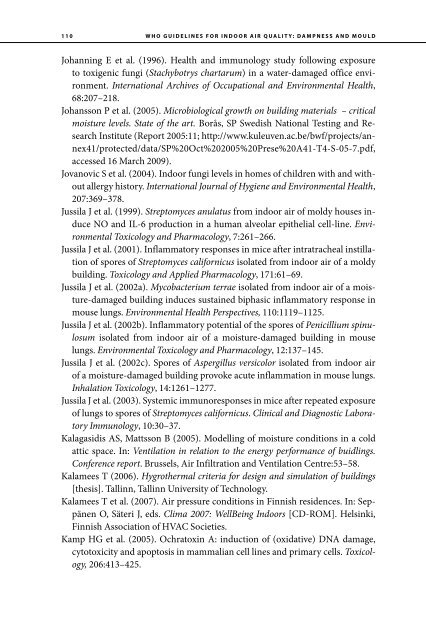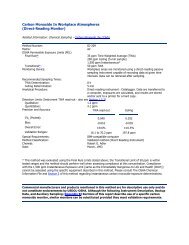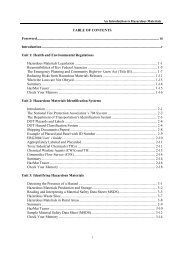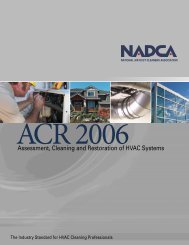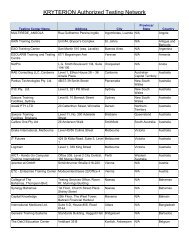Dampness and Mould - WHO guidelines for indoor air quality - PRWeb
Dampness and Mould - WHO guidelines for indoor air quality - PRWeb
Dampness and Mould - WHO guidelines for indoor air quality - PRWeb
You also want an ePaper? Increase the reach of your titles
YUMPU automatically turns print PDFs into web optimized ePapers that Google loves.
110<br />
<strong>WHO</strong> GUIDELINES FOR INDOOR AIR QUALITY: DAMPNESS AND MOULD<br />
Johanning E et al. (1996). Health <strong>and</strong> immunology study following exposure<br />
to toxigenic fungi (Stachybotrys chartarum) in a water-damaged office environment.<br />
International Archives of Occupational <strong>and</strong> Environmental Health,<br />
68:207–218.<br />
Johansson P et al. (2005). Microbiological growth on building materials – critical<br />
moisture levels. State of the art. Borås, SP Swedish National Testing <strong>and</strong> Research<br />
Institute (Report 2005:11; http://www.kuleuven.ac.be/bwf/projects/annex41/protected/data/SP%20Oct%202005%20Prese%20A41-T4-S-05-7.pdf,<br />
accessed 16 March 2009).<br />
Jovanovic S et al. (2004). Indoor fungi levels in homes of children with <strong>and</strong> without<br />
allergy history. International Journal of Hygiene <strong>and</strong> Environmental Health,<br />
207:369–378.<br />
Jussila J et al. (1999). Streptomyces anulatus from <strong>indoor</strong> <strong>air</strong> of moldy houses induce<br />
NO <strong>and</strong> IL-6 production in a human alveolar epithelial cell-line. Environmental<br />
Toxicology <strong>and</strong> Pharmacology, 7:261–266.<br />
Jussila J et al. (2001). Inflammatory responses in mice after intratracheal instillation<br />
of spores of Streptomyces cali<strong>for</strong>nicus isolated from <strong>indoor</strong> <strong>air</strong> of a moldy<br />
building. Toxicology <strong>and</strong> Applied Pharmacology, 171:61–69.<br />
Jussila J et al. (2002a). Mycobacterium terrae isolated from <strong>indoor</strong> <strong>air</strong> of a moisture-damaged<br />
building induces sustained biphasic inflammatory response in<br />
mouse lungs. Environmental Health Perspectives, 110:1119–1125.<br />
Jussila J et al. (2002b). Inflammatory potential of the spores of Penicillium spinulosum<br />
isolated from <strong>indoor</strong> <strong>air</strong> of a moisture-damaged building in mouse<br />
lungs. Environmental Toxicology <strong>and</strong> Pharmacology, 12:137–145.<br />
Jussila J et al. (2002c). Spores of Aspergillus versicolor isolated from <strong>indoor</strong> <strong>air</strong><br />
of a moisture-damaged building provoke acute inflammation in mouse lungs.<br />
Inhalation Toxicology, 14:1261–1277.<br />
Jussila J et al. (2003). Systemic immunoresponses in mice after repeated exposure<br />
of lungs to spores of Streptomyces cali<strong>for</strong>nicus. Clinical <strong>and</strong> Diagnostic Laboratory<br />
Immunology, 10:30–37.<br />
Kalagasidis AS, Mattsson B (2005). Modelling of moisture conditions in a cold<br />
attic space. In: Ventilation in relation to the energy per<strong>for</strong>mance of buidlings.<br />
Conference report. Brussels, Air Infiltration <strong>and</strong> Ventilation Centre:53–58.<br />
Kalamees T (2006). Hygrothermal criteria <strong>for</strong> design <strong>and</strong> simulation of buildings<br />
[thesis]. Tallinn, Tallinn University of Technology.<br />
Kalamees T et al. (2007). Air pressure conditions in Finnish residences. In: Seppänen<br />
O, Säteri J, eds. Clima 2007: WellBeing Indoors [CD-ROM]. Helsinki,<br />
Finnish Association of HVAC Societies.<br />
Kamp HG et al. (2005). Ochratoxin A: induction of (oxidative) DNA damage,<br />
cytotoxicity <strong>and</strong> apoptosis in mammalian cell lines <strong>and</strong> primary cells. Toxicology,<br />
206:413–425.


